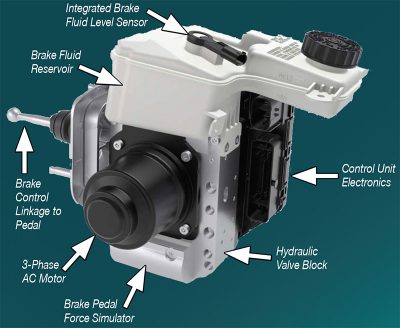Starting with the BMW X5 G05 chassis, BMW has rolled out an integrated braking system. BMW has used electro-hydraulic brake-by-wire systems for over a decade, starting with the X6 E72 chassis; however, only recently is it being used on conventionally driven vehicles in a widespread manner.
DSCi is another step towards electrification and offers many benefits over previous DSC systems. It can be integrated with driver assistance systems, offers improved braking performance, component reduction, and provides increased safety. DSCi uses a 3 phase AC motor which greatly reduces hydraulic pressure build-up time resulting in more precise DSC intervention.
DSC or ABS control operation events no longer create pressure pulses on the brake pedal. Furthermore, pulsing of the brake pedal due to excessive lateral runout of the brake discs can no longer be perceived by the driver. The BMW M8 G15 chassis also comes with driver control of brake pedal firmness by means of selecting ‘comfort’ or ‘sport’ braking characteristics through the iDrive menu.
When utilizing brake-by-wire mode the brake pedal effort is sensed by a travel sensor incorporated into the DSCi. The hydraulic pressure generated by the brake pedal movement acts on a brake pedal force simulator which generates the appropriate counterforce to provide the driver with braking feedback. The travel sensor signal is processed by the DSCi electronics, and a linear actuator driven by an AC motor is utilized to route the generated brake pressure to the disc brake system. The need for a vacuum brake servo and conventional master cylinder is eliminated.
DSCi does, however, incorporate an internal tandem master cylinder to be used in the fallback level in the event of failure of the electrical system. Several other safety measures are incorporated such as fluid leakage detection software by means of monitoring the brake fluid level sensor with four integrated Hall effect sensors, and the brake pressure sensor. The system is intelligent enough to determine which hydraulic circuit is leaking by closing and opening the two pressure retaining valves in succession while monitoring the brake pressure. It will then permanently close the leaking circuit via the corresponding pressure retaining valve.
The DSCi electronics monitors plausibility of the brake pedal travel sensor, brake pressure, linear travel sensor, wheel speed, brake fluid level, and brake pad linings to ensure safe and reliable operation. Moreover, when the data bus is awakened, the DSCi preforms a pre-flight check of the internal separator valve, diagnosis valve, and linear actuator.
The DSCi consists of two electronic control units which share a printed circuit board and microprocessor. The Virtual Integration Platform (VIP) is the second electronic control unit within the DSCi. It performs many value computations based on the signals of various external sensors such as yaw and acceleration sensors. Consequential to integration is reduced serviceability and, as such, if the electronic control unit fails, the DSCi can only be purchased and replaced as a complete assembly.
After replacement, programming/encoding is required along with several ABL service functions such as bleeding, pressure sensor adjustment, and adjustment of dynamic drive sensors. Thus far most failures have been software related (programming abort or software updates based on service bulletins); however, some internal sensor failures have been developing.






0 Comments